Drug Card Assignment: Pharmacology and Drug Information
VerifiedAdded on 2020/04/01
|47
|6837
|43
Homework Assignment
AI Summary
This assignment presents a series of drug cards, each detailing a specific medication and its clinical profile. The drugs covered include Atenolol, Ativan, Calcium, Carbamazepine, Celexa, Clonazepam, Clopidogrel, Codeine, Combivent, dexamethasone, Digoxin, and Dilantin. Each drug card provides information on the generic name, classification, normal dosage and route of administration, peak and duration, mechanism of action, therapeutic uses, contraindications, potential adverse effects, nursing implications and considerations, and patient/family teaching points. The assignment offers a comprehensive overview of each drug's pharmacology, clinical application, and nursing management, making it a valuable resource for students learning about medication administration and patient care.
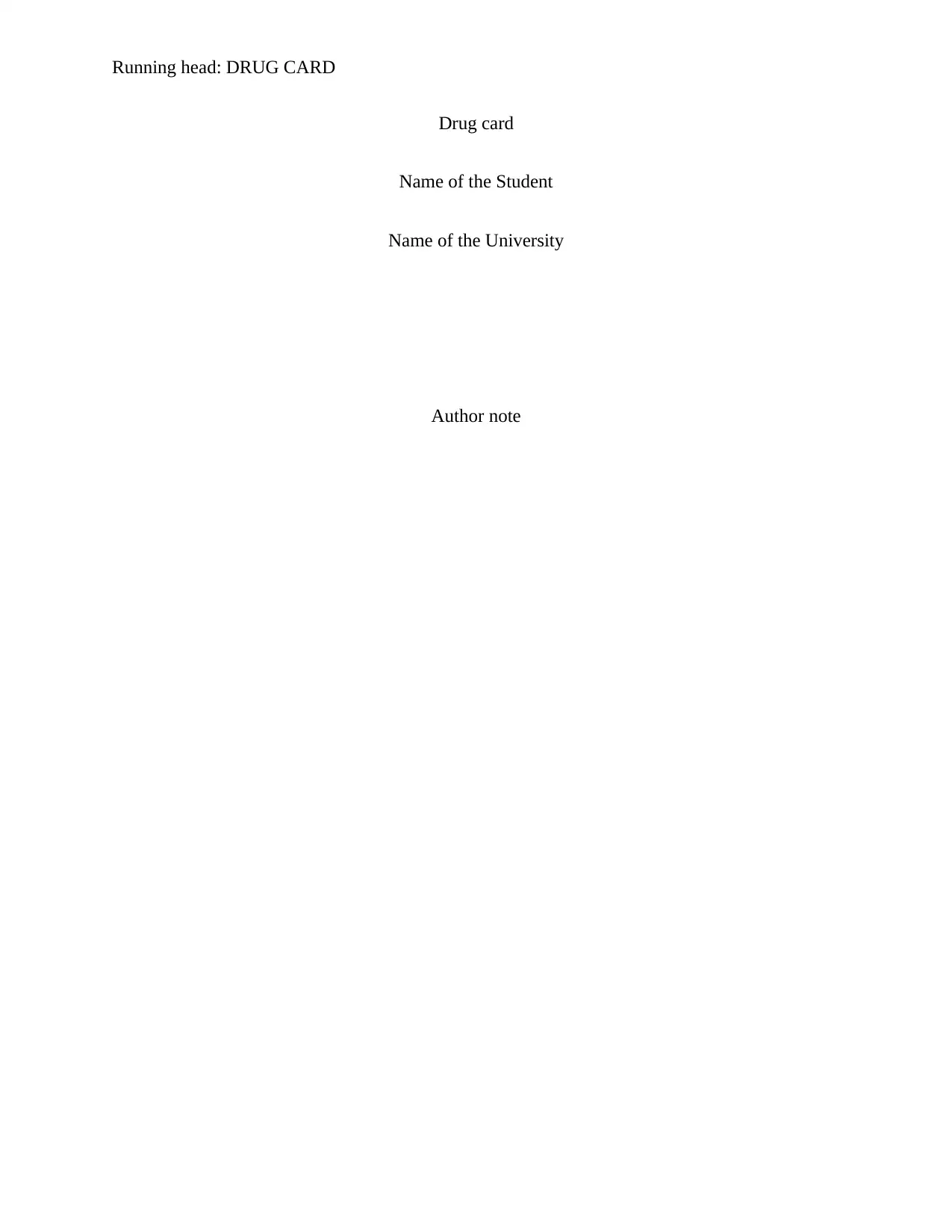
Running head: DRUG CARD
Drug card
Name of the Student
Name of the University
Author note
Drug card
Name of the Student
Name of the University
Author note
Paraphrase This Document
Need a fresh take? Get an instant paraphrase of this document with our AI Paraphraser
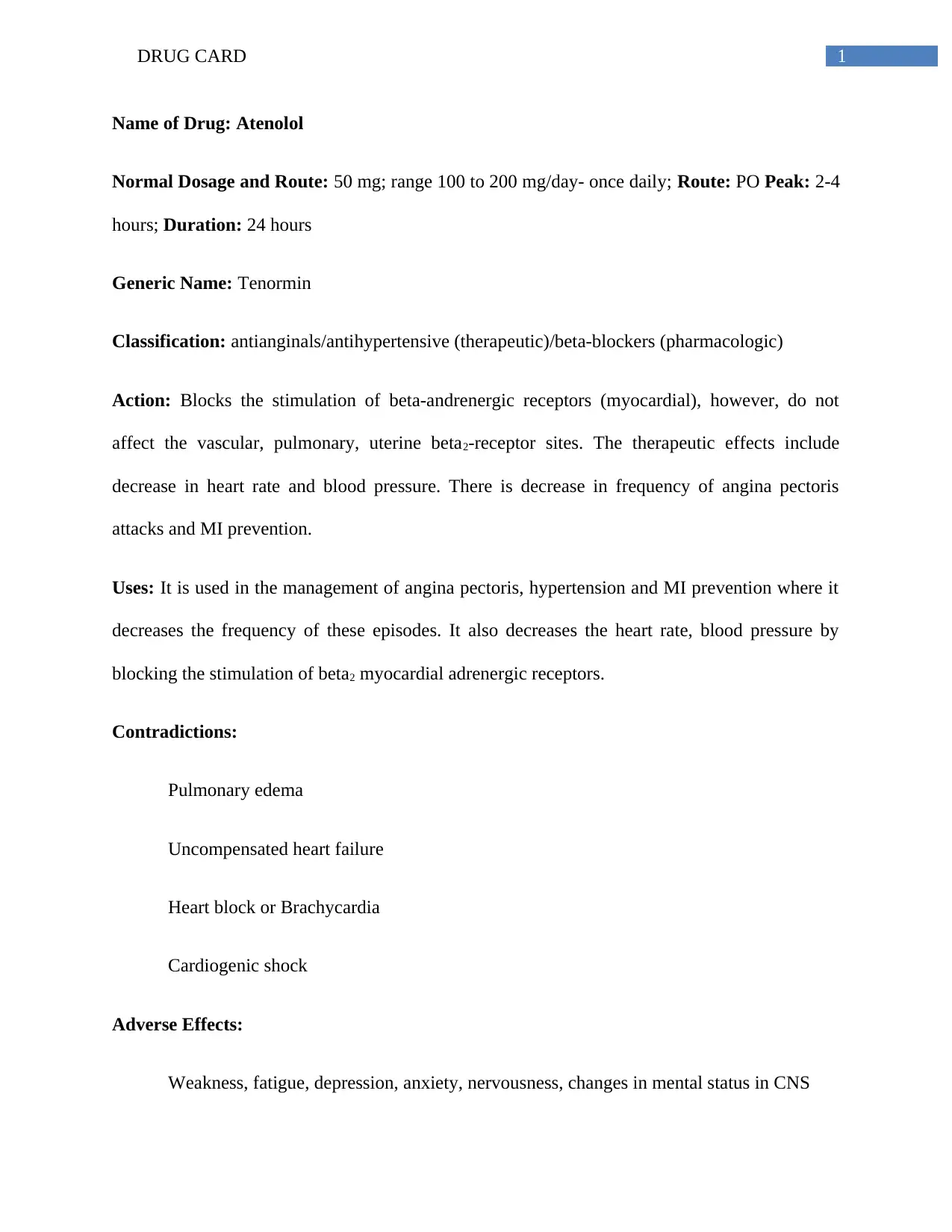
1DRUG CARD
Name of Drug: Atenolol
Normal Dosage and Route: 50 mg; range 100 to 200 mg/day- once daily; Route: PO Peak: 2-4
hours; Duration: 24 hours
Generic Name: Tenormin
Classification: antianginals/antihypertensive (therapeutic)/beta-blockers (pharmacologic)
Action: Blocks the stimulation of beta-andrenergic receptors (myocardial), however, do not
affect the vascular, pulmonary, uterine beta2-receptor sites. The therapeutic effects include
decrease in heart rate and blood pressure. There is decrease in frequency of angina pectoris
attacks and MI prevention.
Uses: It is used in the management of angina pectoris, hypertension and MI prevention where it
decreases the frequency of these episodes. It also decreases the heart rate, blood pressure by
blocking the stimulation of beta2 myocardial adrenergic receptors.
Contradictions:
Pulmonary edema
Uncompensated heart failure
Heart block or Brachycardia
Cardiogenic shock
Adverse Effects:
Weakness, fatigue, depression, anxiety, nervousness, changes in mental status in CNS
Name of Drug: Atenolol
Normal Dosage and Route: 50 mg; range 100 to 200 mg/day- once daily; Route: PO Peak: 2-4
hours; Duration: 24 hours
Generic Name: Tenormin
Classification: antianginals/antihypertensive (therapeutic)/beta-blockers (pharmacologic)
Action: Blocks the stimulation of beta-andrenergic receptors (myocardial), however, do not
affect the vascular, pulmonary, uterine beta2-receptor sites. The therapeutic effects include
decrease in heart rate and blood pressure. There is decrease in frequency of angina pectoris
attacks and MI prevention.
Uses: It is used in the management of angina pectoris, hypertension and MI prevention where it
decreases the frequency of these episodes. It also decreases the heart rate, blood pressure by
blocking the stimulation of beta2 myocardial adrenergic receptors.
Contradictions:
Pulmonary edema
Uncompensated heart failure
Heart block or Brachycardia
Cardiogenic shock
Adverse Effects:
Weakness, fatigue, depression, anxiety, nervousness, changes in mental status in CNS
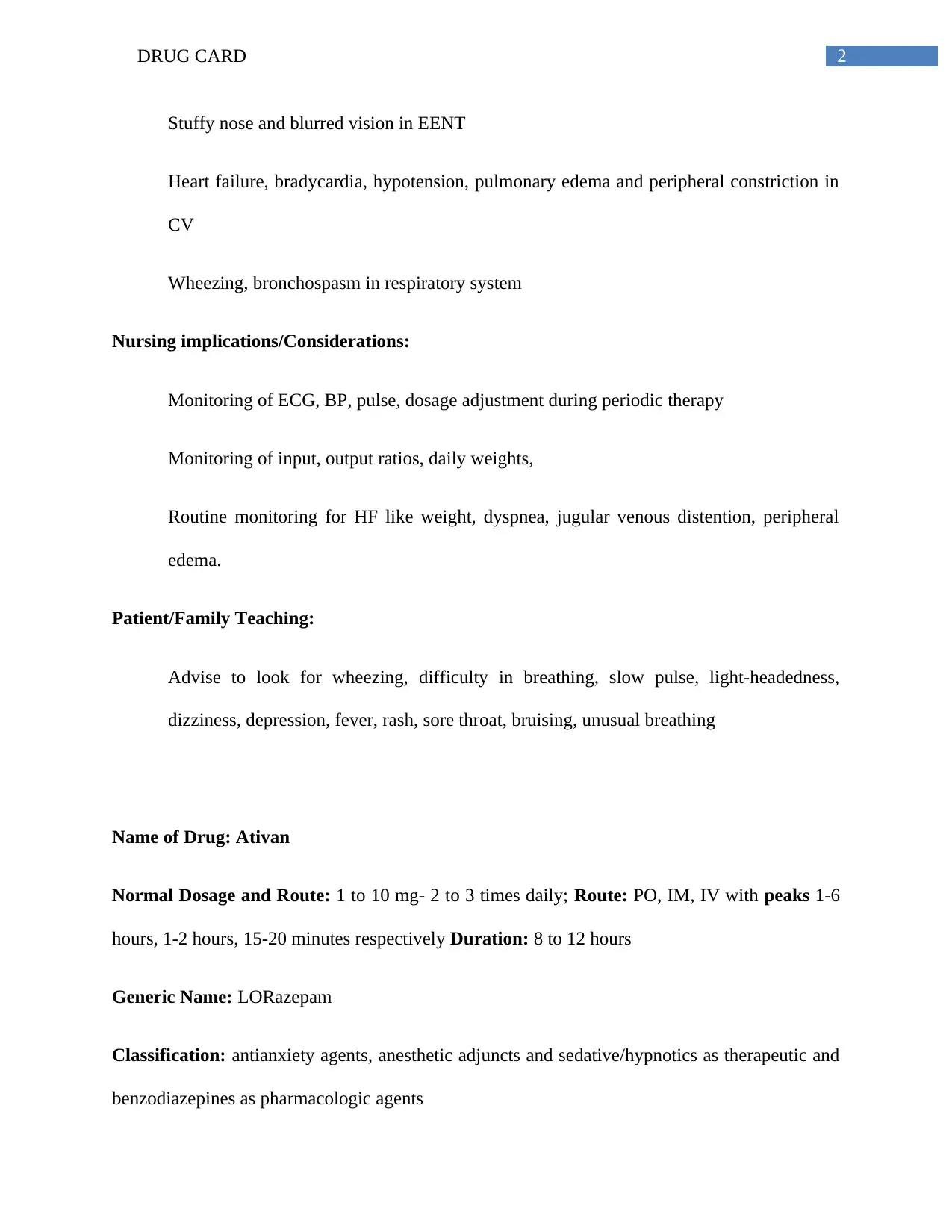
2DRUG CARD
Stuffy nose and blurred vision in EENT
Heart failure, bradycardia, hypotension, pulmonary edema and peripheral constriction in
CV
Wheezing, bronchospasm in respiratory system
Nursing implications/Considerations:
Monitoring of ECG, BP, pulse, dosage adjustment during periodic therapy
Monitoring of input, output ratios, daily weights,
Routine monitoring for HF like weight, dyspnea, jugular venous distention, peripheral
edema.
Patient/Family Teaching:
Advise to look for wheezing, difficulty in breathing, slow pulse, light-headedness,
dizziness, depression, fever, rash, sore throat, bruising, unusual breathing
Name of Drug: Ativan
Normal Dosage and Route: 1 to 10 mg- 2 to 3 times daily; Route: PO, IM, IV with peaks 1-6
hours, 1-2 hours, 15-20 minutes respectively Duration: 8 to 12 hours
Generic Name: LORazepam
Classification: antianxiety agents, anesthetic adjuncts and sedative/hypnotics as therapeutic and
benzodiazepines as pharmacologic agents
Stuffy nose and blurred vision in EENT
Heart failure, bradycardia, hypotension, pulmonary edema and peripheral constriction in
CV
Wheezing, bronchospasm in respiratory system
Nursing implications/Considerations:
Monitoring of ECG, BP, pulse, dosage adjustment during periodic therapy
Monitoring of input, output ratios, daily weights,
Routine monitoring for HF like weight, dyspnea, jugular venous distention, peripheral
edema.
Patient/Family Teaching:
Advise to look for wheezing, difficulty in breathing, slow pulse, light-headedness,
dizziness, depression, fever, rash, sore throat, bruising, unusual breathing
Name of Drug: Ativan
Normal Dosage and Route: 1 to 10 mg- 2 to 3 times daily; Route: PO, IM, IV with peaks 1-6
hours, 1-2 hours, 15-20 minutes respectively Duration: 8 to 12 hours
Generic Name: LORazepam
Classification: antianxiety agents, anesthetic adjuncts and sedative/hypnotics as therapeutic and
benzodiazepines as pharmacologic agents
⊘ This is a preview!⊘
Do you want full access?
Subscribe today to unlock all pages.

Trusted by 1+ million students worldwide
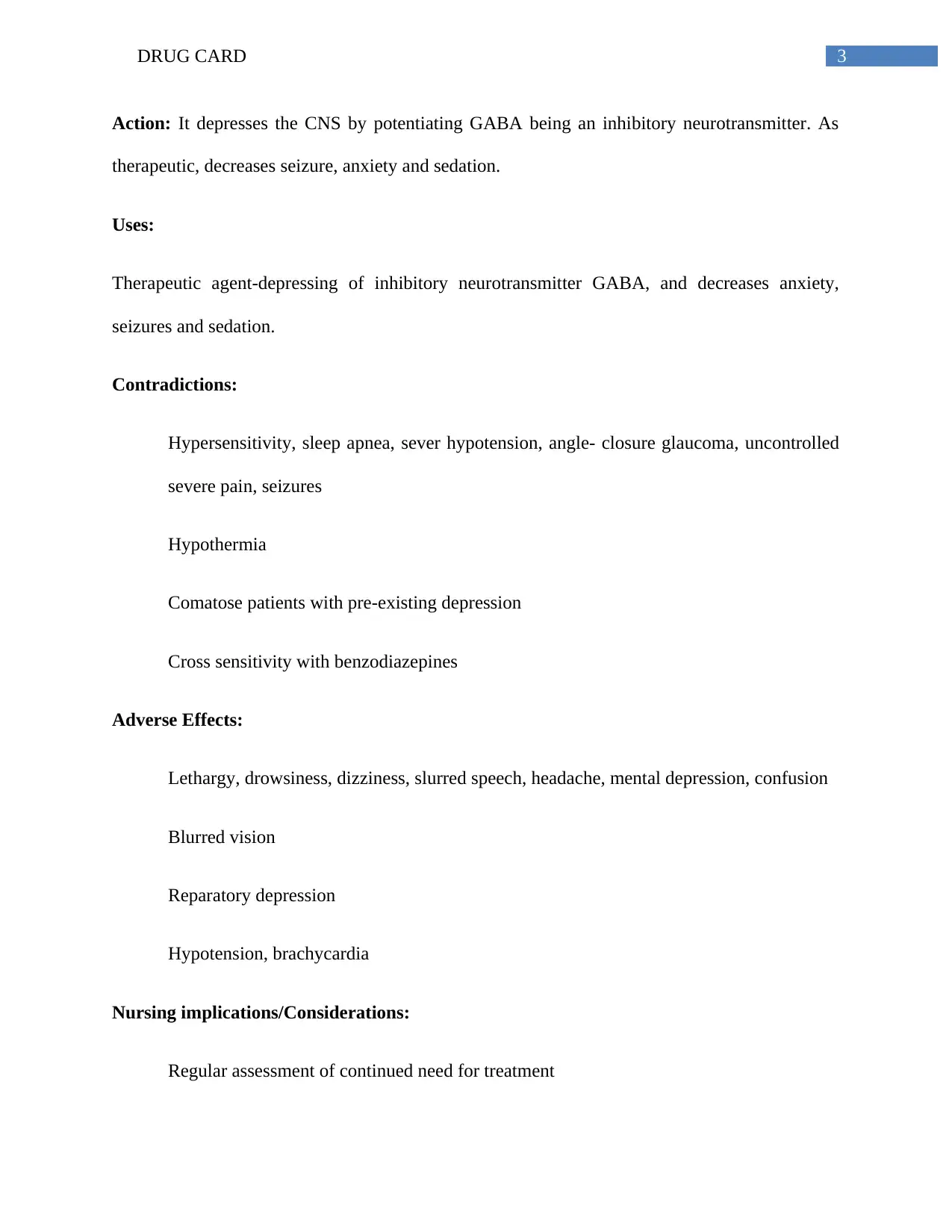
3DRUG CARD
Action: It depresses the CNS by potentiating GABA being an inhibitory neurotransmitter. As
therapeutic, decreases seizure, anxiety and sedation.
Uses:
Therapeutic agent-depressing of inhibitory neurotransmitter GABA, and decreases anxiety,
seizures and sedation.
Contradictions:
Hypersensitivity, sleep apnea, sever hypotension, angle- closure glaucoma, uncontrolled
severe pain, seizures
Hypothermia
Comatose patients with pre-existing depression
Cross sensitivity with benzodiazepines
Adverse Effects:
Lethargy, drowsiness, dizziness, slurred speech, headache, mental depression, confusion
Blurred vision
Reparatory depression
Hypotension, brachycardia
Nursing implications/Considerations:
Regular assessment of continued need for treatment
Action: It depresses the CNS by potentiating GABA being an inhibitory neurotransmitter. As
therapeutic, decreases seizure, anxiety and sedation.
Uses:
Therapeutic agent-depressing of inhibitory neurotransmitter GABA, and decreases anxiety,
seizures and sedation.
Contradictions:
Hypersensitivity, sleep apnea, sever hypotension, angle- closure glaucoma, uncontrolled
severe pain, seizures
Hypothermia
Comatose patients with pre-existing depression
Cross sensitivity with benzodiazepines
Adverse Effects:
Lethargy, drowsiness, dizziness, slurred speech, headache, mental depression, confusion
Blurred vision
Reparatory depression
Hypotension, brachycardia
Nursing implications/Considerations:
Regular assessment of continued need for treatment
Paraphrase This Document
Need a fresh take? Get an instant paraphrase of this document with our AI Paraphraser
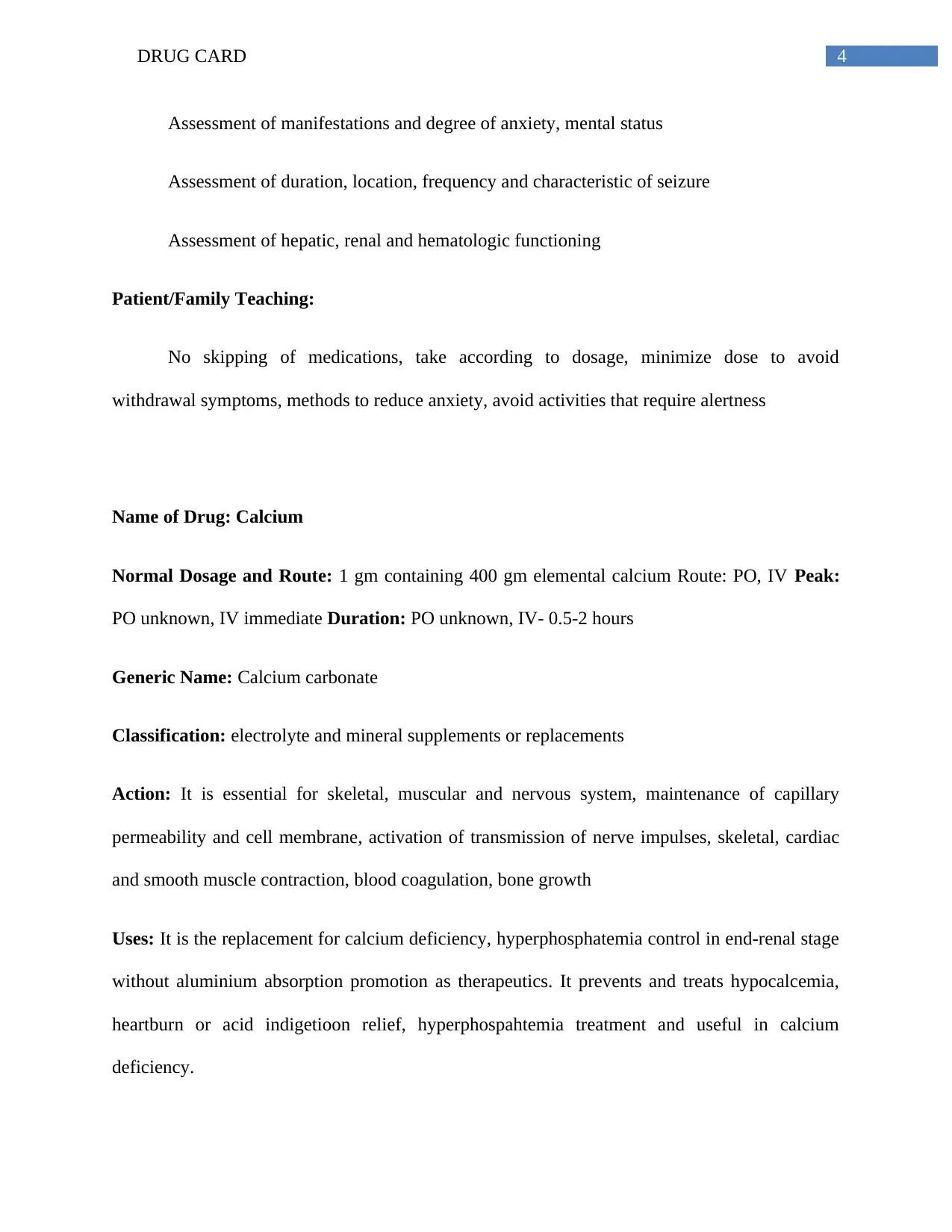
4DRUG CARD
Assessment of manifestations and degree of anxiety, mental status
Assessment of duration, location, frequency and characteristic of seizure
Assessment of hepatic, renal and hematologic functioning
Patient/Family Teaching:
No skipping of medications, take according to dosage, minimize dose to avoid
withdrawal symptoms, methods to reduce anxiety, avoid activities that require alertness
Name of Drug: Calcium
Normal Dosage and Route: 1 gm containing 400 gm elemental calcium Route: PO, IV Peak:
PO unknown, IV immediate Duration: PO unknown, IV- 0.5-2 hours
Generic Name: Calcium carbonate
Classification: electrolyte and mineral supplements or replacements
Action: It is essential for skeletal, muscular and nervous system, maintenance of capillary
permeability and cell membrane, activation of transmission of nerve impulses, skeletal, cardiac
and smooth muscle contraction, blood coagulation, bone growth
Uses: It is the replacement for calcium deficiency, hyperphosphatemia control in end-renal stage
without aluminium absorption promotion as therapeutics. It prevents and treats hypocalcemia,
heartburn or acid indigetioon relief, hyperphospahtemia treatment and useful in calcium
deficiency.
Assessment of manifestations and degree of anxiety, mental status
Assessment of duration, location, frequency and characteristic of seizure
Assessment of hepatic, renal and hematologic functioning
Patient/Family Teaching:
No skipping of medications, take according to dosage, minimize dose to avoid
withdrawal symptoms, methods to reduce anxiety, avoid activities that require alertness
Name of Drug: Calcium
Normal Dosage and Route: 1 gm containing 400 gm elemental calcium Route: PO, IV Peak:
PO unknown, IV immediate Duration: PO unknown, IV- 0.5-2 hours
Generic Name: Calcium carbonate
Classification: electrolyte and mineral supplements or replacements
Action: It is essential for skeletal, muscular and nervous system, maintenance of capillary
permeability and cell membrane, activation of transmission of nerve impulses, skeletal, cardiac
and smooth muscle contraction, blood coagulation, bone growth
Uses: It is the replacement for calcium deficiency, hyperphosphatemia control in end-renal stage
without aluminium absorption promotion as therapeutics. It prevents and treats hypocalcemia,
heartburn or acid indigetioon relief, hyperphospahtemia treatment and useful in calcium
deficiency.
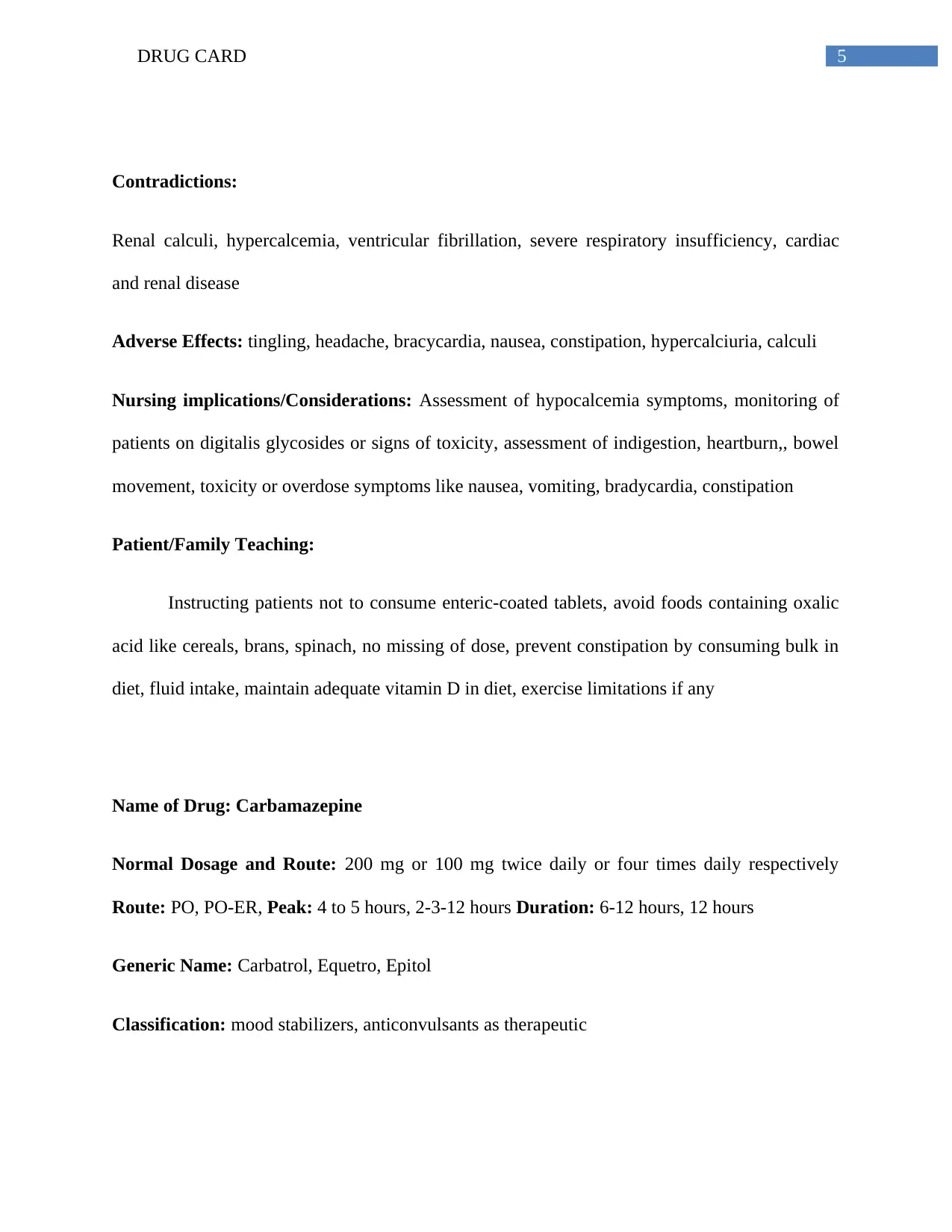
5DRUG CARD
Contradictions:
Renal calculi, hypercalcemia, ventricular fibrillation, severe respiratory insufficiency, cardiac
and renal disease
Adverse Effects: tingling, headache, bracycardia, nausea, constipation, hypercalciuria, calculi
Nursing implications/Considerations: Assessment of hypocalcemia symptoms, monitoring of
patients on digitalis glycosides or signs of toxicity, assessment of indigestion, heartburn,, bowel
movement, toxicity or overdose symptoms like nausea, vomiting, bradycardia, constipation
Patient/Family Teaching:
Instructing patients not to consume enteric-coated tablets, avoid foods containing oxalic
acid like cereals, brans, spinach, no missing of dose, prevent constipation by consuming bulk in
diet, fluid intake, maintain adequate vitamin D in diet, exercise limitations if any
Name of Drug: Carbamazepine
Normal Dosage and Route: 200 mg or 100 mg twice daily or four times daily respectively
Route: PO, PO-ER, Peak: 4 to 5 hours, 2-3-12 hours Duration: 6-12 hours, 12 hours
Generic Name: Carbatrol, Equetro, Epitol
Classification: mood stabilizers, anticonvulsants as therapeutic
Contradictions:
Renal calculi, hypercalcemia, ventricular fibrillation, severe respiratory insufficiency, cardiac
and renal disease
Adverse Effects: tingling, headache, bracycardia, nausea, constipation, hypercalciuria, calculi
Nursing implications/Considerations: Assessment of hypocalcemia symptoms, monitoring of
patients on digitalis glycosides or signs of toxicity, assessment of indigestion, heartburn,, bowel
movement, toxicity or overdose symptoms like nausea, vomiting, bradycardia, constipation
Patient/Family Teaching:
Instructing patients not to consume enteric-coated tablets, avoid foods containing oxalic
acid like cereals, brans, spinach, no missing of dose, prevent constipation by consuming bulk in
diet, fluid intake, maintain adequate vitamin D in diet, exercise limitations if any
Name of Drug: Carbamazepine
Normal Dosage and Route: 200 mg or 100 mg twice daily or four times daily respectively
Route: PO, PO-ER, Peak: 4 to 5 hours, 2-3-12 hours Duration: 6-12 hours, 12 hours
Generic Name: Carbatrol, Equetro, Epitol
Classification: mood stabilizers, anticonvulsants as therapeutic
⊘ This is a preview!⊘
Do you want full access?
Subscribe today to unlock all pages.

Trusted by 1+ million students worldwide
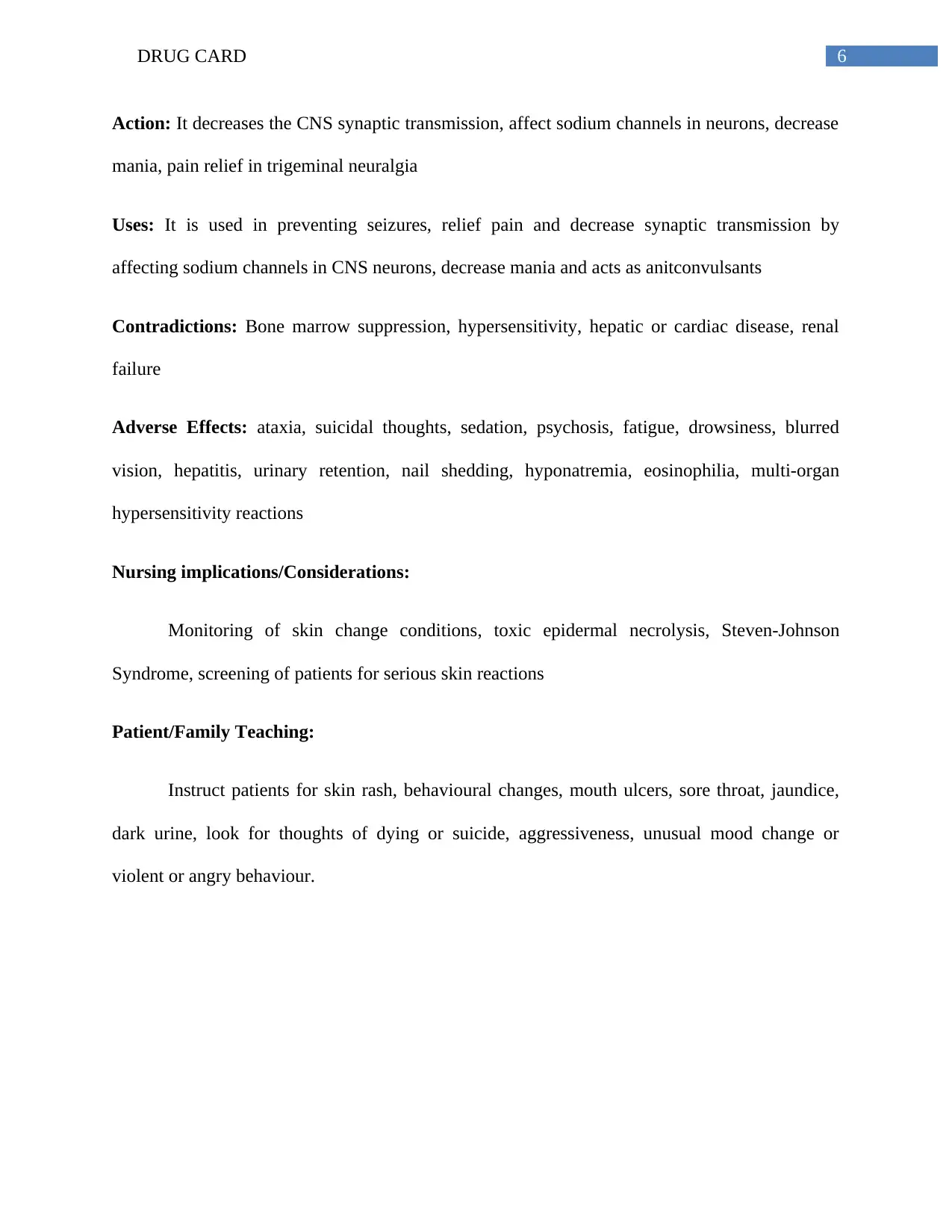
6DRUG CARD
Action: It decreases the CNS synaptic transmission, affect sodium channels in neurons, decrease
mania, pain relief in trigeminal neuralgia
Uses: It is used in preventing seizures, relief pain and decrease synaptic transmission by
affecting sodium channels in CNS neurons, decrease mania and acts as anitconvulsants
Contradictions: Bone marrow suppression, hypersensitivity, hepatic or cardiac disease, renal
failure
Adverse Effects: ataxia, suicidal thoughts, sedation, psychosis, fatigue, drowsiness, blurred
vision, hepatitis, urinary retention, nail shedding, hyponatremia, eosinophilia, multi-organ
hypersensitivity reactions
Nursing implications/Considerations:
Monitoring of skin change conditions, toxic epidermal necrolysis, Steven-Johnson
Syndrome, screening of patients for serious skin reactions
Patient/Family Teaching:
Instruct patients for skin rash, behavioural changes, mouth ulcers, sore throat, jaundice,
dark urine, look for thoughts of dying or suicide, aggressiveness, unusual mood change or
violent or angry behaviour.
Action: It decreases the CNS synaptic transmission, affect sodium channels in neurons, decrease
mania, pain relief in trigeminal neuralgia
Uses: It is used in preventing seizures, relief pain and decrease synaptic transmission by
affecting sodium channels in CNS neurons, decrease mania and acts as anitconvulsants
Contradictions: Bone marrow suppression, hypersensitivity, hepatic or cardiac disease, renal
failure
Adverse Effects: ataxia, suicidal thoughts, sedation, psychosis, fatigue, drowsiness, blurred
vision, hepatitis, urinary retention, nail shedding, hyponatremia, eosinophilia, multi-organ
hypersensitivity reactions
Nursing implications/Considerations:
Monitoring of skin change conditions, toxic epidermal necrolysis, Steven-Johnson
Syndrome, screening of patients for serious skin reactions
Patient/Family Teaching:
Instruct patients for skin rash, behavioural changes, mouth ulcers, sore throat, jaundice,
dark urine, look for thoughts of dying or suicide, aggressiveness, unusual mood change or
violent or angry behaviour.
Paraphrase This Document
Need a fresh take? Get an instant paraphrase of this document with our AI Paraphraser
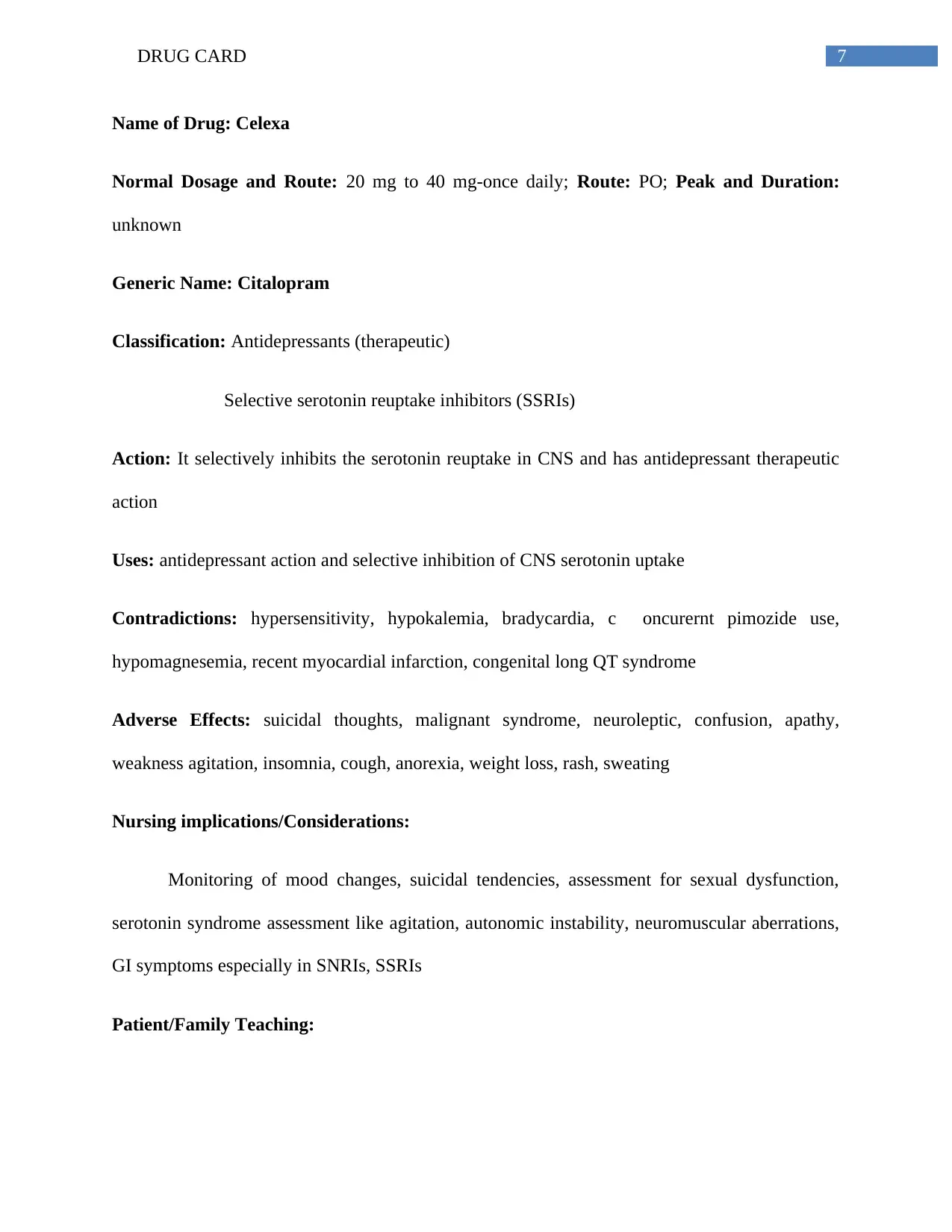
7DRUG CARD
Name of Drug: Celexa
Normal Dosage and Route: 20 mg to 40 mg-once daily; Route: PO; Peak and Duration:
unknown
Generic Name: Citalopram
Classification: Antidepressants (therapeutic)
Selective serotonin reuptake inhibitors (SSRIs)
Action: It selectively inhibits the serotonin reuptake in CNS and has antidepressant therapeutic
action
Uses: antidepressant action and selective inhibition of CNS serotonin uptake
Contradictions: hypersensitivity, hypokalemia, bradycardia, c oncurernt pimozide use,
hypomagnesemia, recent myocardial infarction, congenital long QT syndrome
Adverse Effects: suicidal thoughts, malignant syndrome, neuroleptic, confusion, apathy,
weakness agitation, insomnia, cough, anorexia, weight loss, rash, sweating
Nursing implications/Considerations:
Monitoring of mood changes, suicidal tendencies, assessment for sexual dysfunction,
serotonin syndrome assessment like agitation, autonomic instability, neuromuscular aberrations,
GI symptoms especially in SNRIs, SSRIs
Patient/Family Teaching:
Name of Drug: Celexa
Normal Dosage and Route: 20 mg to 40 mg-once daily; Route: PO; Peak and Duration:
unknown
Generic Name: Citalopram
Classification: Antidepressants (therapeutic)
Selective serotonin reuptake inhibitors (SSRIs)
Action: It selectively inhibits the serotonin reuptake in CNS and has antidepressant therapeutic
action
Uses: antidepressant action and selective inhibition of CNS serotonin uptake
Contradictions: hypersensitivity, hypokalemia, bradycardia, c oncurernt pimozide use,
hypomagnesemia, recent myocardial infarction, congenital long QT syndrome
Adverse Effects: suicidal thoughts, malignant syndrome, neuroleptic, confusion, apathy,
weakness agitation, insomnia, cough, anorexia, weight loss, rash, sweating
Nursing implications/Considerations:
Monitoring of mood changes, suicidal tendencies, assessment for sexual dysfunction,
serotonin syndrome assessment like agitation, autonomic instability, neuromuscular aberrations,
GI symptoms especially in SNRIs, SSRIs
Patient/Family Teaching:
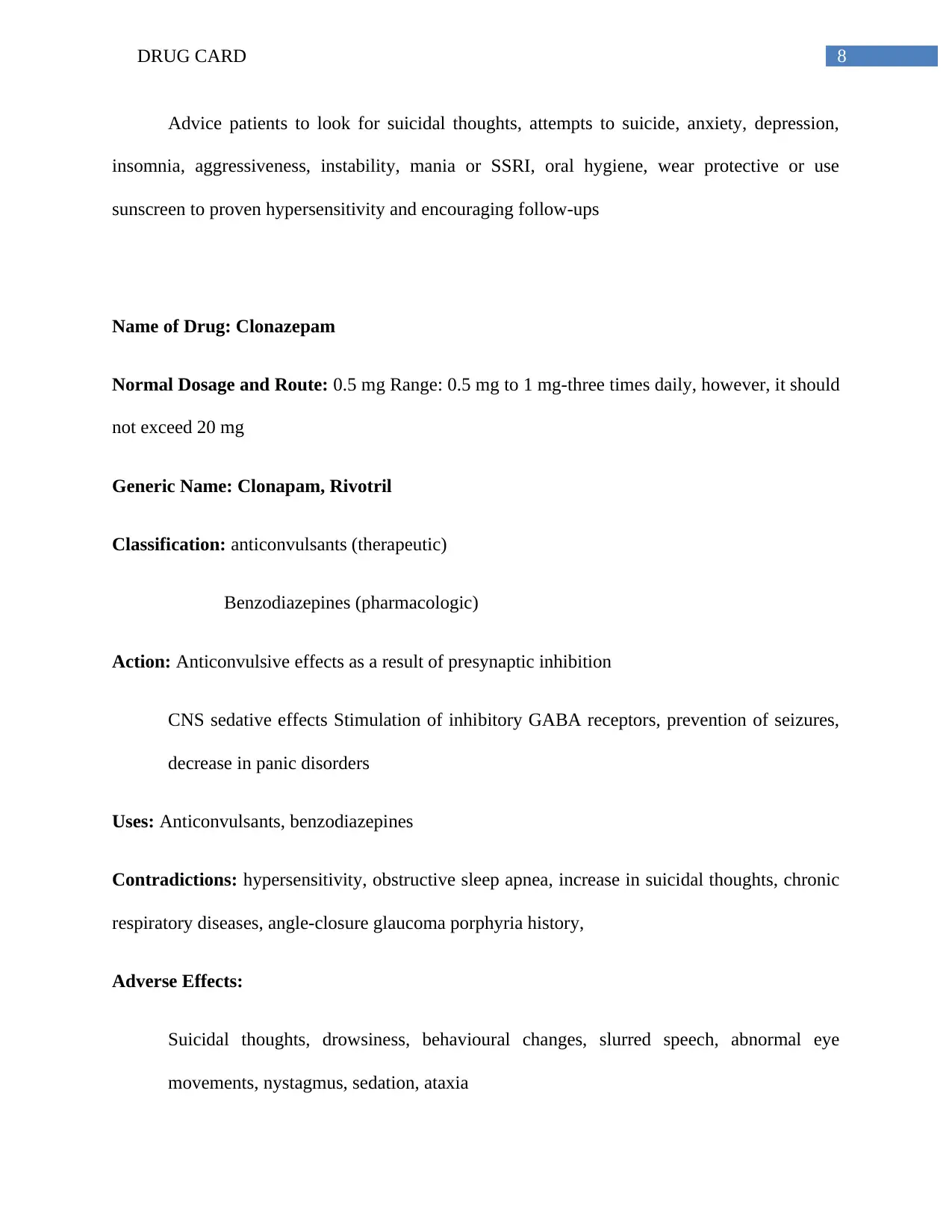
8DRUG CARD
Advice patients to look for suicidal thoughts, attempts to suicide, anxiety, depression,
insomnia, aggressiveness, instability, mania or SSRI, oral hygiene, wear protective or use
sunscreen to proven hypersensitivity and encouraging follow-ups
Name of Drug: Clonazepam
Normal Dosage and Route: 0.5 mg Range: 0.5 mg to 1 mg-three times daily, however, it should
not exceed 20 mg
Generic Name: Clonapam, Rivotril
Classification: anticonvulsants (therapeutic)
Benzodiazepines (pharmacologic)
Action: Anticonvulsive effects as a result of presynaptic inhibition
CNS sedative effects Stimulation of inhibitory GABA receptors, prevention of seizures,
decrease in panic disorders
Uses: Anticonvulsants, benzodiazepines
Contradictions: hypersensitivity, obstructive sleep apnea, increase in suicidal thoughts, chronic
respiratory diseases, angle-closure glaucoma porphyria history,
Adverse Effects:
Suicidal thoughts, drowsiness, behavioural changes, slurred speech, abnormal eye
movements, nystagmus, sedation, ataxia
Advice patients to look for suicidal thoughts, attempts to suicide, anxiety, depression,
insomnia, aggressiveness, instability, mania or SSRI, oral hygiene, wear protective or use
sunscreen to proven hypersensitivity and encouraging follow-ups
Name of Drug: Clonazepam
Normal Dosage and Route: 0.5 mg Range: 0.5 mg to 1 mg-three times daily, however, it should
not exceed 20 mg
Generic Name: Clonapam, Rivotril
Classification: anticonvulsants (therapeutic)
Benzodiazepines (pharmacologic)
Action: Anticonvulsive effects as a result of presynaptic inhibition
CNS sedative effects Stimulation of inhibitory GABA receptors, prevention of seizures,
decrease in panic disorders
Uses: Anticonvulsants, benzodiazepines
Contradictions: hypersensitivity, obstructive sleep apnea, increase in suicidal thoughts, chronic
respiratory diseases, angle-closure glaucoma porphyria history,
Adverse Effects:
Suicidal thoughts, drowsiness, behavioural changes, slurred speech, abnormal eye
movements, nystagmus, sedation, ataxia
⊘ This is a preview!⊘
Do you want full access?
Subscribe today to unlock all pages.

Trusted by 1+ million students worldwide
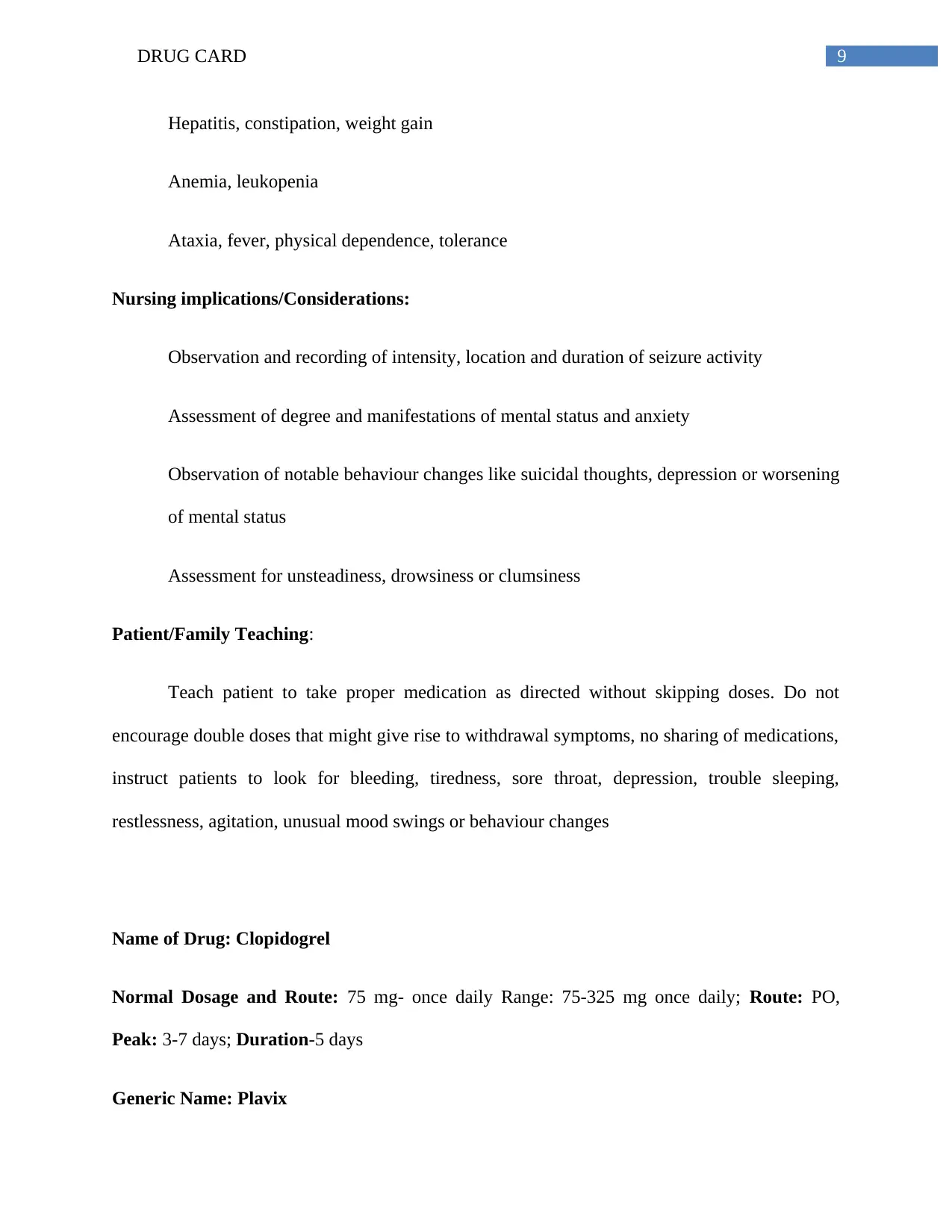
9DRUG CARD
Hepatitis, constipation, weight gain
Anemia, leukopenia
Ataxia, fever, physical dependence, tolerance
Nursing implications/Considerations:
Observation and recording of intensity, location and duration of seizure activity
Assessment of degree and manifestations of mental status and anxiety
Observation of notable behaviour changes like suicidal thoughts, depression or worsening
of mental status
Assessment for unsteadiness, drowsiness or clumsiness
Patient/Family Teaching:
Teach patient to take proper medication as directed without skipping doses. Do not
encourage double doses that might give rise to withdrawal symptoms, no sharing of medications,
instruct patients to look for bleeding, tiredness, sore throat, depression, trouble sleeping,
restlessness, agitation, unusual mood swings or behaviour changes
Name of Drug: Clopidogrel
Normal Dosage and Route: 75 mg- once daily Range: 75-325 mg once daily; Route: PO,
Peak: 3-7 days; Duration-5 days
Generic Name: Plavix
Hepatitis, constipation, weight gain
Anemia, leukopenia
Ataxia, fever, physical dependence, tolerance
Nursing implications/Considerations:
Observation and recording of intensity, location and duration of seizure activity
Assessment of degree and manifestations of mental status and anxiety
Observation of notable behaviour changes like suicidal thoughts, depression or worsening
of mental status
Assessment for unsteadiness, drowsiness or clumsiness
Patient/Family Teaching:
Teach patient to take proper medication as directed without skipping doses. Do not
encourage double doses that might give rise to withdrawal symptoms, no sharing of medications,
instruct patients to look for bleeding, tiredness, sore throat, depression, trouble sleeping,
restlessness, agitation, unusual mood swings or behaviour changes
Name of Drug: Clopidogrel
Normal Dosage and Route: 75 mg- once daily Range: 75-325 mg once daily; Route: PO,
Peak: 3-7 days; Duration-5 days
Generic Name: Plavix
Paraphrase This Document
Need a fresh take? Get an instant paraphrase of this document with our AI Paraphraser
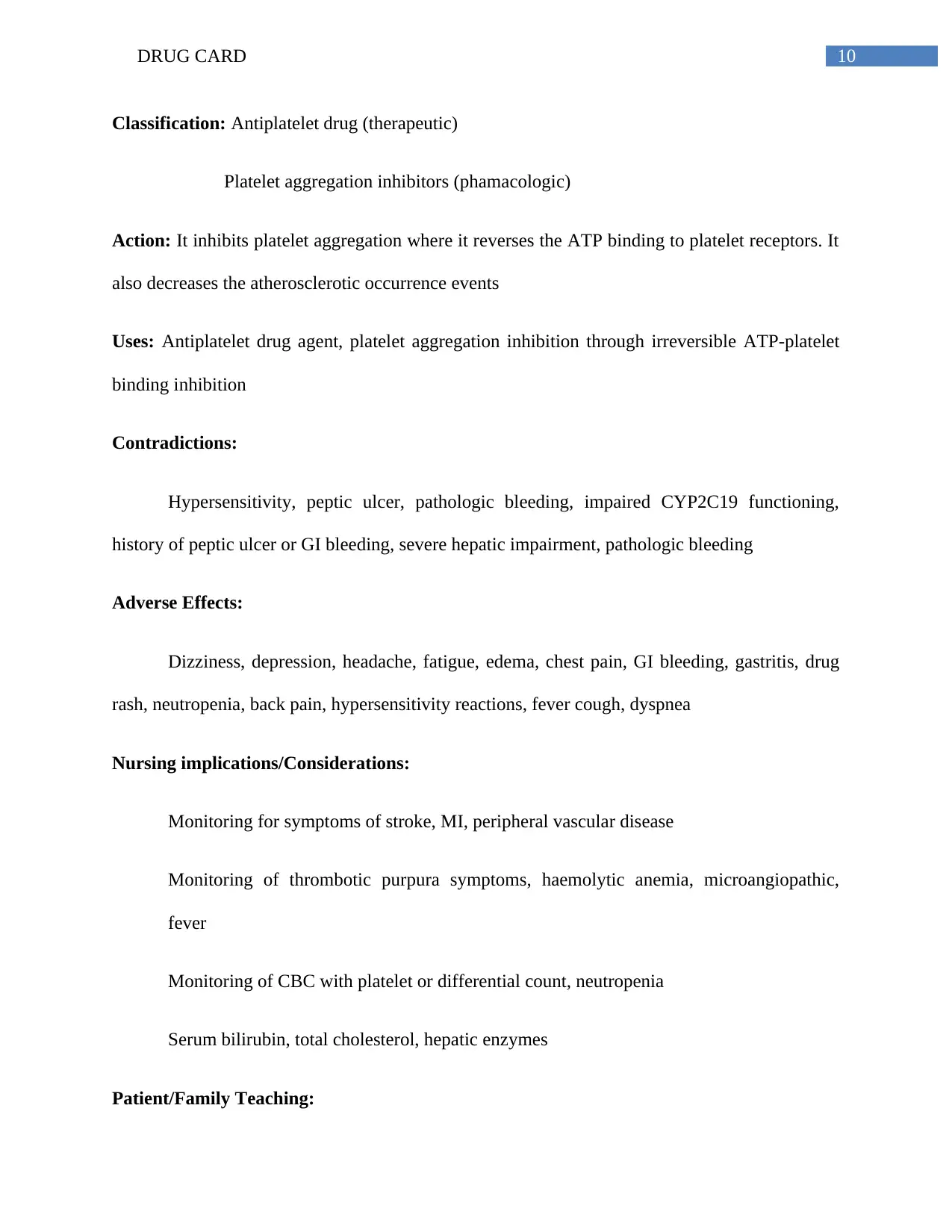
10DRUG CARD
Classification: Antiplatelet drug (therapeutic)
Platelet aggregation inhibitors (phamacologic)
Action: It inhibits platelet aggregation where it reverses the ATP binding to platelet receptors. It
also decreases the atherosclerotic occurrence events
Uses: Antiplatelet drug agent, platelet aggregation inhibition through irreversible ATP-platelet
binding inhibition
Contradictions:
Hypersensitivity, peptic ulcer, pathologic bleeding, impaired CYP2C19 functioning,
history of peptic ulcer or GI bleeding, severe hepatic impairment, pathologic bleeding
Adverse Effects:
Dizziness, depression, headache, fatigue, edema, chest pain, GI bleeding, gastritis, drug
rash, neutropenia, back pain, hypersensitivity reactions, fever cough, dyspnea
Nursing implications/Considerations:
Monitoring for symptoms of stroke, MI, peripheral vascular disease
Monitoring of thrombotic purpura symptoms, haemolytic anemia, microangiopathic,
fever
Monitoring of CBC with platelet or differential count, neutropenia
Serum bilirubin, total cholesterol, hepatic enzymes
Patient/Family Teaching:
Classification: Antiplatelet drug (therapeutic)
Platelet aggregation inhibitors (phamacologic)
Action: It inhibits platelet aggregation where it reverses the ATP binding to platelet receptors. It
also decreases the atherosclerotic occurrence events
Uses: Antiplatelet drug agent, platelet aggregation inhibition through irreversible ATP-platelet
binding inhibition
Contradictions:
Hypersensitivity, peptic ulcer, pathologic bleeding, impaired CYP2C19 functioning,
history of peptic ulcer or GI bleeding, severe hepatic impairment, pathologic bleeding
Adverse Effects:
Dizziness, depression, headache, fatigue, edema, chest pain, GI bleeding, gastritis, drug
rash, neutropenia, back pain, hypersensitivity reactions, fever cough, dyspnea
Nursing implications/Considerations:
Monitoring for symptoms of stroke, MI, peripheral vascular disease
Monitoring of thrombotic purpura symptoms, haemolytic anemia, microangiopathic,
fever
Monitoring of CBC with platelet or differential count, neutropenia
Serum bilirubin, total cholesterol, hepatic enzymes
Patient/Family Teaching:
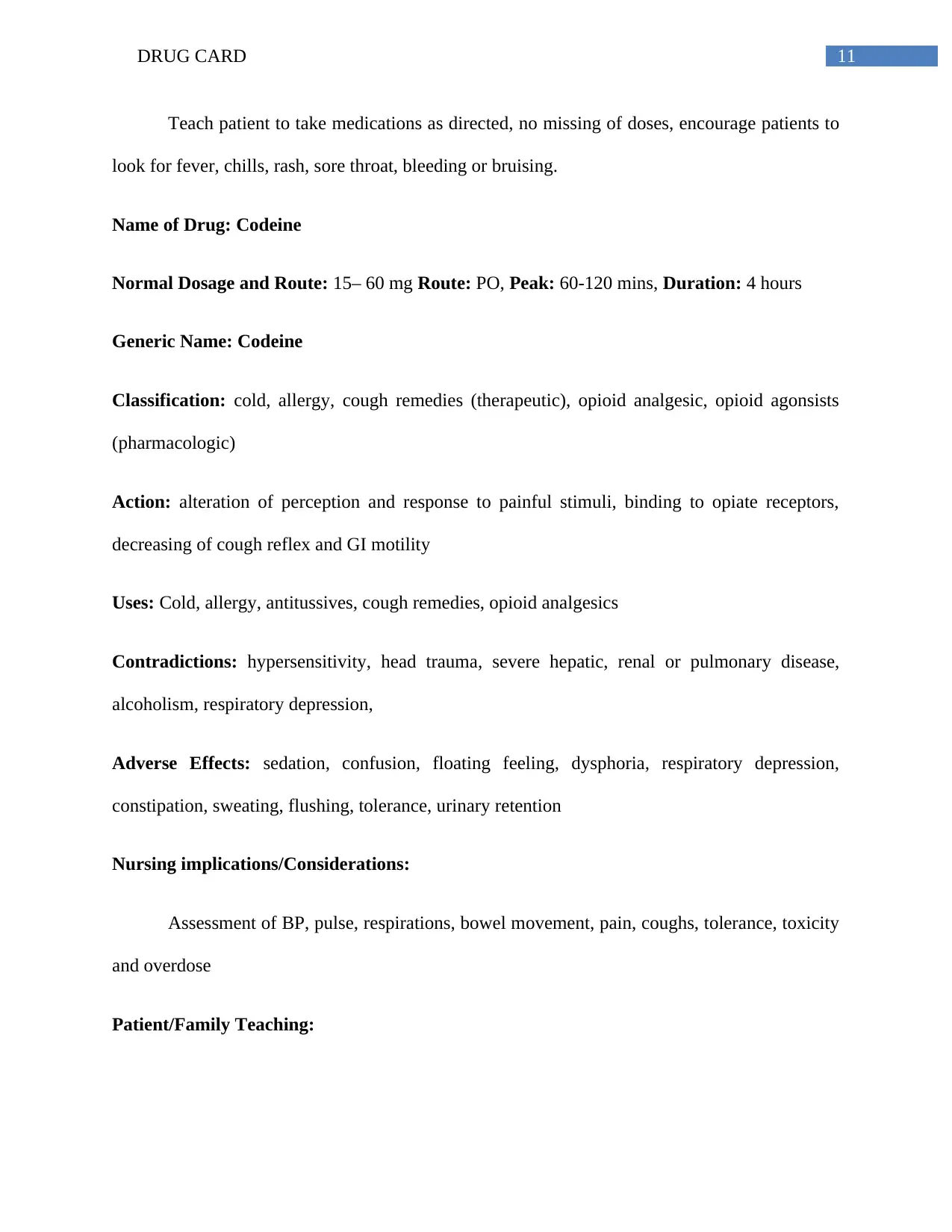
11DRUG CARD
Teach patient to take medications as directed, no missing of doses, encourage patients to
look for fever, chills, rash, sore throat, bleeding or bruising.
Name of Drug: Codeine
Normal Dosage and Route: 15– 60 mg Route: PO, Peak: 60-120 mins, Duration: 4 hours
Generic Name: Codeine
Classification: cold, allergy, cough remedies (therapeutic), opioid analgesic, opioid agonsists
(pharmacologic)
Action: alteration of perception and response to painful stimuli, binding to opiate receptors,
decreasing of cough reflex and GI motility
Uses: Cold, allergy, antitussives, cough remedies, opioid analgesics
Contradictions: hypersensitivity, head trauma, severe hepatic, renal or pulmonary disease,
alcoholism, respiratory depression,
Adverse Effects: sedation, confusion, floating feeling, dysphoria, respiratory depression,
constipation, sweating, flushing, tolerance, urinary retention
Nursing implications/Considerations:
Assessment of BP, pulse, respirations, bowel movement, pain, coughs, tolerance, toxicity
and overdose
Patient/Family Teaching:
Teach patient to take medications as directed, no missing of doses, encourage patients to
look for fever, chills, rash, sore throat, bleeding or bruising.
Name of Drug: Codeine
Normal Dosage and Route: 15– 60 mg Route: PO, Peak: 60-120 mins, Duration: 4 hours
Generic Name: Codeine
Classification: cold, allergy, cough remedies (therapeutic), opioid analgesic, opioid agonsists
(pharmacologic)
Action: alteration of perception and response to painful stimuli, binding to opiate receptors,
decreasing of cough reflex and GI motility
Uses: Cold, allergy, antitussives, cough remedies, opioid analgesics
Contradictions: hypersensitivity, head trauma, severe hepatic, renal or pulmonary disease,
alcoholism, respiratory depression,
Adverse Effects: sedation, confusion, floating feeling, dysphoria, respiratory depression,
constipation, sweating, flushing, tolerance, urinary retention
Nursing implications/Considerations:
Assessment of BP, pulse, respirations, bowel movement, pain, coughs, tolerance, toxicity
and overdose
Patient/Family Teaching:
⊘ This is a preview!⊘
Do you want full access?
Subscribe today to unlock all pages.

Trusted by 1+ million students worldwide
1 out of 47
Your All-in-One AI-Powered Toolkit for Academic Success.
+13062052269
info@desklib.com
Available 24*7 on WhatsApp / Email
![[object Object]](/_next/static/media/star-bottom.7253800d.svg)
Unlock your academic potential
Copyright © 2020–2025 A2Z Services. All Rights Reserved. Developed and managed by ZUCOL.